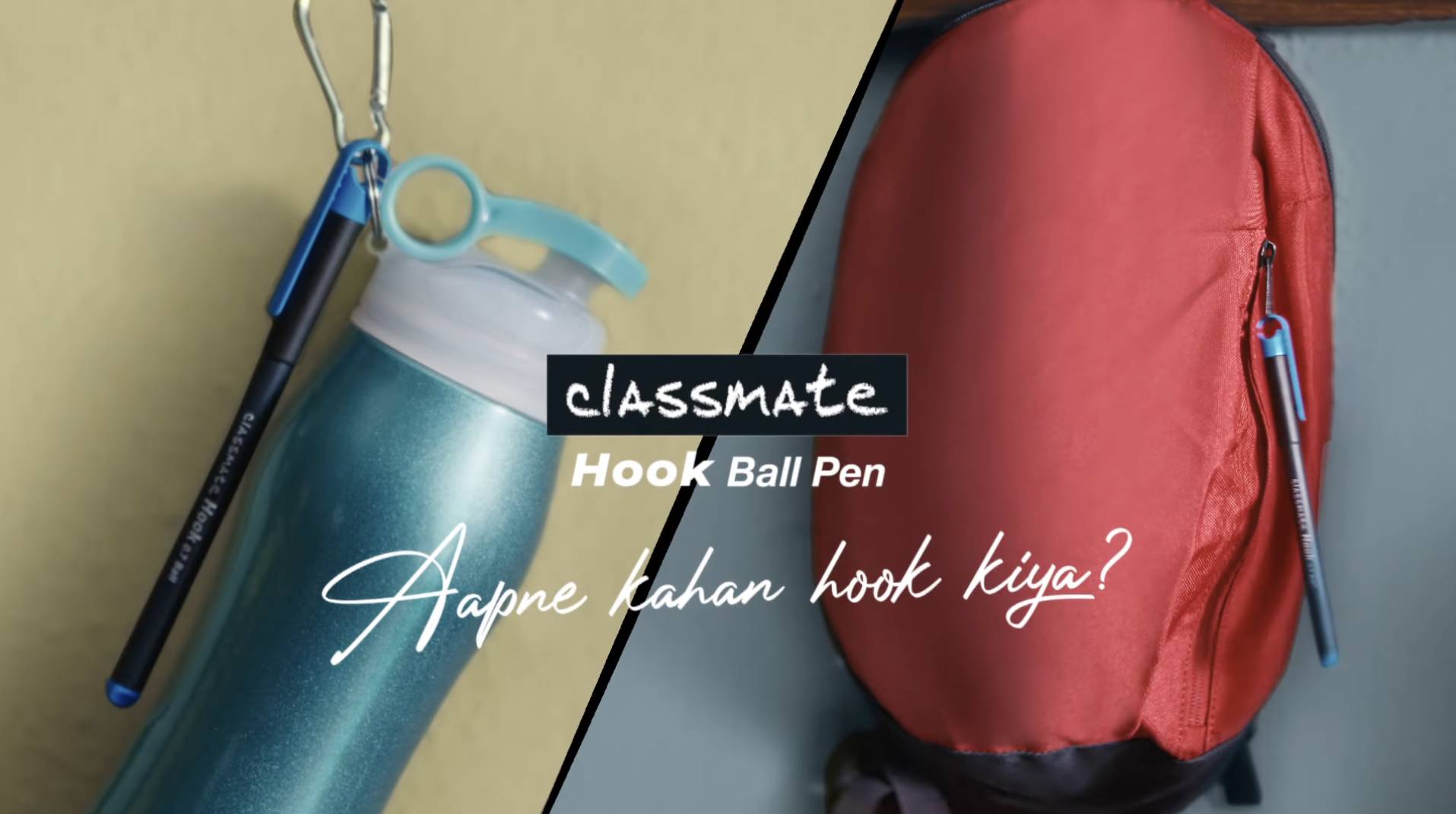
I saw the new ad for ITC Classmate Hook Ball Pen only after Eularie Saldanha wrote about it in Campaign India.
The title of the piece went, “Does Classmate want school kids to mate?”.

Now, having read only that preposterous title, I saw the ad before I read Eularie’s commentary about the ad. I highly recommend this to everyone reading my commentary on ads too – please watch whatever I’m pointing to, in whatever context, before reading my commentary so that you get an opportunity to form your own perspective before getting colored with mine.
Then, I read Eularie’s point of view. Here it is, on the Campaign India website.
There are quite a few open-ended questions in the commentary:
“is it okay for brands promoting education and its products to leave such blanks about what their messaging is?”
“Is it a possibility that young girls are imbecilic enough to ‘hook up’ because the opposite gender offers a gesture of kindness – as simple as lending a pen?”
“is it funny to be punny in ads belonging to categories like these which might actually influence young kids at a time these products are most relevant?”
Since I watched the ad before reading the commentary, here’s what I thought about the ad.
A girl comes and asks two boys, seated on the stairs, if they have a pen. One of them gets up, emphatically says, ‘Of course!’, and goes on to search for his pen at all the predictable places – his jacket pocket, shirt pocket, pant pocket, etc. But, he couldn’t find his pen.
The way he searches for the pen has been done in a comical, dance’ish routine and it made me smile. So, I didn’t find it out of the ordinary that it made the girl smile too, as per the script.
The other boy, takes his spiral-bound notebook and flicks it lightly to reveal the ITC Classmate Hook Ball Pen hooked to the top of the spiral binding.
The difference between both boys’ approaches is made glaringly obvious – the classic Lord Ganesha vs. Lord Murugan story involving the divine fruit. So, one boy is the conventional one – he keeps his pen in conventional places and is missing it when in need. The other one is the unconventional one (ITC hoping that this becomes the new convention… or the new trend, I assume) and keeps his pen close to where it may be used more often. And hence, he knows where to look for the pen when in need.
I haven’t bought a pen for myself in many, many years, but I have bought quite a few pens for my kids and I have not come across this idea either from them or the shopkeeper. So I found this idea to be quite clever.
The girl obviously finds this to be clever too – both the action of keeping the pen hooked to the notebook (which is the entire point of the product in the first place) and the fact that the boy thought of this idea (helpfully seeded by ITC and Ogilvy).
And when she returns the pen back, she says ‘Smooth’, immediately after we are shown that she wrote with the pen. So I connected it directly to the pen’s writing capability – this is something the brand has to showcase anyway since a pen’s primary purpose is to write, and where to hang it—or hook it—is only incidental.
But I was surprised by Eularie’s insinuation about this gesture: “where does one’s mind go, when the storyline begins with two boys trying hard to impress a girl, flirtatious eye contact when the girl says ‘smooth’ – not certain if it was hinted at the pen, or at the boy”.
I did not see the girl’s eye contact as ‘flirtatious’. I read it as, ‘Ok, this is a clever way to hold a pen that also happens to write smoothly. This boy seems intelligent/clever’.
What Eularie hinted at possibly being ‘flirtatious’, I saw it as ‘impressed’. I really don’t think it is wrong to be visibly impressed with another person’s intelligence no matter how old or young the concerned people are. That ‘being impressed’ can also be read as ‘flirtatious’ because the concerned people are at an impressionable age says more about the evolution of our society than anything else.
And then the catchphrase: ‘Aapne kahan hook kiya?’ (Where did you hook?)
I did not read this the way Eularie did, alluding to “possibly promotes the hook-up culture among school students”.
Why? For 3 reasons.
1. The catchphrase is shown on the screen that also shows, in the background, two more ways of hooking the pen: the chain of the water bottle, and the zipper of the bag. So I understood it as opening up more possibilities of where else one can hook this pen conveniently, instead of simply keeping it in the shirt pocket.

2. There is no reference to hook-up anywhere in the ad. It remains ‘hook’ all through. A hook has multiple references, including, the catchy part of a song, for example. This broadly means the reference is to something that connects quickly and stays – the song’s catchy part or the pen’s convenient curve on the cap.
3. The catchphrase uses where; as in ‘where do you want to hook your pen?’. Not who; as in who do you want to hook up with? The latter is not implied in any way; only imagined. Is the ad asking one to imagine that? I did not think so.
My reading of the ad was simply this:
Boy 1 could not find his pen because he keeps it in all the conventional places.
Boy 2 found his pen instantly because it was hooked to his notebook.
Girl found the idea of hooking the pen to the notebook to be interesting and clever, and was clearly impressed at both the idea and the boy who had thought of the idea.
The pen also writes smoothly, of course, as exclaimed by the girl – this applies to the pen’s writing capabilities, and possibly to the boy who had thought of a unique idea that others haven’t.
What I disagree with in Eularie’s commentary is the stretch that ‘being impressed’ can also be implied as ‘wanting to hook up’.
Yes, the first boy wanted to impress the girl by being the first to offer the pen.
Yes, the girl is impressed with the second boy’s idea of hooking the pen to the notebook.
But should these be extrapolated to “possibly promotes the hook-up culture among school students”? I thought that was a massive stretch because that not only undermines the intelligence of these youngsters but also implies a sweeping loss of innocence over a mere pen (and the clever act of using the pen in a new way).
The stretch that I’m referring to occurs here: if the girl is clearly and visibly impressed with the idea of hooking the pen to the notebook, and hence, with the smartness of the boy who came up with that idea, that could simply be that – ‘I’m impressed’.
It could perhaps move to them talking to each other more often. Studying together. Exchanging other interests, like music, sports, books, and movies. Getting to know each other. And generally being friends.
There’s a whole wide world of opportunities between ‘being impressed with the boy who had a nifty way to hook the pen to a notebook’ to ‘they are hooking up with each other’. To insinuate that this is the intended/unintended depiction while ignoring everything else in between seems like a failure of imagination, innocence, and consideration of the possibilities, particularly when seen on the back of the simple fact that all this is for just being impressed with how to keep a pen!!
Eularie says, “Ambiguity might work for a lot of brands that want to say something, but leave some space for justification, should a question of character arise”.
I would say that the justification is perhaps in the way each person sees the ad, and it need not be hammered, underlined, or spoonfed. That is, the ad does not need to scream that it is not promoting ‘hook-up’ culture and that it certainly does not ‘want school kids to mate’ (cringe!) because the product’s name is ‘Classmate’.
And just because it is not spoonfed to us in the most categorical way, we need not breathlessly extrapolate ‘being impressed’ with ‘Oh, are they going to hook up next? And go on dates? And… and… and… and… like a page 3 tabloid. ‘Being impressed’ can remain precisely there because the brand or the agency, in the script, does not imply anything more.
Our youngsters perhaps deserve the benefit of the doubt more often instead of condescension. We were young once in the recent past too and we would have wanted the same benefit of the doubt from the adults around us at that point.
Oh, and if we are going to imply things, what about the boy and the girl—Oh, God!!!—sitting next to each other and talking to each other, in the background?

